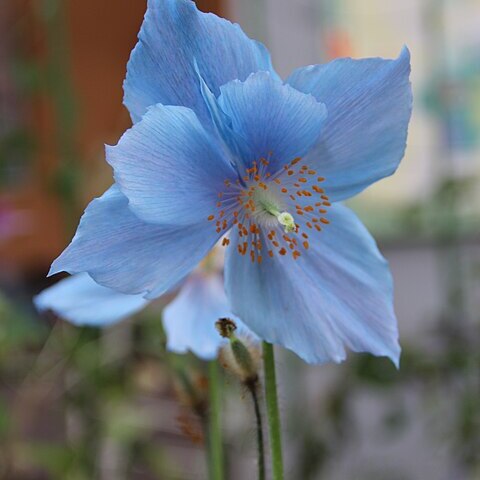Herbs, perennial. Taproot narrowly radishlike or fibrous; rootstock shortly branched, rubiginous villous. Stems erect, 40-120 cm tall, stout, sparsely extended or slightly deflexed setose. Basal leaves: petiole 10-17 cm, sparsely brown barbellate-villous, basally with ampliate sheath; blade pale green abaxially, green adaxially, narrowly oblanceolate to lanceolate-oblong or elliptic-oblong, 15-26 × 5-8.4 cm, both surfaces brown barbellate-pilose, midvein broad, lateral veins distinct, base attenuate into petiole, margin distantly irregularly serrate or broadly crenate, apex acute or nearly acute. Lower cauline leaves similar to basal leaves, but upper cauline leaves increasingly smaller, uppermost 3-5-pseudoverticillate, sessile. Flowers rarely more than 3, from upper leaf whorl, very rarely from lower cauline axils. Pedicel to 45 cm at fruiting. Flowers nutant, large. Petals 4, rarely 5, blue, purple, or lilac-purple, nearly orbicular or broadly obovate, 6.2-8 × 4.8-7.6 cm. Filaments white, filiform, 7-15 mm; anthers orange or yellow, oblong, 1-2 mm. Ovary green, ovoid or oblong, glabrous or densely pilose; styles 7-10 mm; stigmas green, clavate, 4-6-lobed. Capsule elliptic-oblong, 2.8-4.4 × 1.2-1.5 cm, 4-6-valvate from apex for a short distance. Seeds reniform, seed coat longitudinally shallowly pitted. Fl. Jun-Aug.
More
A hairy herb. It grows to about 1 m high. It spreads about 40-60 cm wide. The leaves are sword shaped. The lower leaves are about 30 cm long. They have slight teeth. They are covered with stiff golden hairs. The flowers are blue. They occur singly or in groups of 3. The fruit is a capsule 5 cm long and with 4-6 valves.

